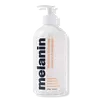What's inside
What's inside
 Key Ingredients
Key Ingredients

 Benefits
Benefits

 Concerns
Concerns

 Ingredients Side-by-side
Ingredients Side-by-side

Water
Skin ConditioningDiheptyl Succinate
EmollientCapryloyl Glycerin/Sebacic Acid Copolymer
Skin ConditioningBehentrimonium Methosulfate
Glycerin
HumectantCetearyl Alcohol
EmollientPanthenol
Skin ConditioningAloe Barbadensis Leaf Juice
Skin ConditioningSimmondsia Chinensis Seed Oil
EmollientArgania Spinosa Kernel Oil
EmollientWheat Amino Acids
Skin ConditioningHydrolyzed Wheat Protein
Skin ConditioningBrassica Rapa Root Extract
Skin ConditioningCamellia Sinensis Leaf Extract
AntimicrobialChamomilla Recutita Flower Extract
MaskingHumulus Lupulus Extract
AntimicrobialRosmarinus Officinalis Leaf Extract
AntimicrobialHydrolyzed Adansonia Digitata Seed Extract
Bambusa Vulgaris Extract
Skin ConditioningMentha Viridis Leaf Oil
AstringentCaprylhydroxamic Acid
Caprylyl Glycol
EmollientCitric Acid
BufferingWater, Diheptyl Succinate, Capryloyl Glycerin/Sebacic Acid Copolymer, Behentrimonium Methosulfate, Glycerin, Cetearyl Alcohol, Panthenol, Aloe Barbadensis Leaf Juice, Simmondsia Chinensis Seed Oil, Argania Spinosa Kernel Oil, Wheat Amino Acids, Hydrolyzed Wheat Protein, Brassica Rapa Root Extract, Camellia Sinensis Leaf Extract, Chamomilla Recutita Flower Extract, Humulus Lupulus Extract, Rosmarinus Officinalis Leaf Extract, Hydrolyzed Adansonia Digitata Seed Extract, Bambusa Vulgaris Extract, Mentha Viridis Leaf Oil, Caprylhydroxamic Acid, Caprylyl Glycol, Citric Acid
Water
Skin ConditioningGlycerin
HumectantCetearyl Alcohol
EmollientButyrospermum Parkii Butter
Skin ConditioningCetyl Alcohol
EmollientSqualane
EmollientRicinus Communis Seed Oil
MaskingCocos Nucifera Oil
MaskingCetrimonium Bromide
AntimicrobialDimethicone
EmollientTocopheryl Acetate
AntioxidantBisabolol
MaskingHydrolyzed Silk
HumectantHydrolyzed Soy Protein
HumectantCroton Zambesicus Powder
Polyquaternium-32
Paraffinum Liquidum
EmollientPPG-1 Trideceth-6
Skin ConditioningLavandula Angustifolia Oil
MaskingJasminum Officinale Oil
MaskingLippia Citriodora Leaf Oil
MaskingVanilla Planifolia Fruit Oil
EmollientPhenoxyethanol
PreservativeEthylhexylglycerin
Skin ConditioningWater, Glycerin, Cetearyl Alcohol, Butyrospermum Parkii Butter, Cetyl Alcohol, Squalane, Ricinus Communis Seed Oil, Cocos Nucifera Oil, Cetrimonium Bromide, Dimethicone, Tocopheryl Acetate, Bisabolol, Hydrolyzed Silk, Hydrolyzed Soy Protein, Croton Zambesicus Powder, Polyquaternium-32, Paraffinum Liquidum, PPG-1 Trideceth-6, Lavandula Angustifolia Oil, Jasminum Officinale Oil, Lippia Citriodora Leaf Oil, Vanilla Planifolia Fruit Oil, Phenoxyethanol, Ethylhexylglycerin
 Reviews
Reviews

Ingredients Explained
These ingredients are found in both products.
Ingredients higher up in an ingredient list are typically present in a larger amount.
Cetearyl alcohol is a mixture of two fatty alcohols: cetyl alcohol and stearyl alcohol. It is mainly used as an emulsifier. Emulsifiers help prevent the separation of oils and products. Due to its composition, it can also be used to thicken a product or help create foam.
Cetearyl alcohol is an emollient. Emollients help soothe and hydrate the skin by trapping moisture.
Studies show Cetearyl alcohol is non-toxic and non-irritating. The FDA allows products labeled "alcohol-free" to have fatty alcohols.
This ingredient is usually derived from plant oils such as palm, vegetable, or coconut oils. There is debate on whether this ingredient will cause acne.
Due to the fatty acid base, this ingredient may not be Malassezia folliculitis safe.
Learn more about Cetearyl AlcoholGlycerin is already naturally found in your skin. It helps moisturize and protect your skin.
A study from 2016 found glycerin to be more effective as a humectant than AHAs and hyaluronic acid.
As a humectant, it helps the skin stay hydrated by pulling moisture to your skin. The low molecular weight of glycerin allows it to pull moisture into the deeper layers of your skin.
Hydrated skin improves your skin barrier; Your skin barrier helps protect against irritants and bacteria.
Glycerin has also been found to have antimicrobial and antiviral properties. Due to these properties, glycerin is often used in wound and burn treatments.
In cosmetics, glycerin is usually derived from plants such as soybean or palm. However, it can also be sourced from animals, such as tallow or animal fat.
This ingredient is organic, colorless, odorless, and non-toxic.
Glycerin is the name for this ingredient in American English. British English uses Glycerol/Glycerine.
Learn more about GlycerinWater. It's the most common cosmetic ingredient of all. You'll usually see it at the top of ingredient lists, meaning that it makes up the largest part of the product.
So why is it so popular? Water most often acts as a solvent - this means that it helps dissolve other ingredients into the formulation.
You'll also recognize water as that liquid we all need to stay alive. If you see this, drink a glass of water. Stay hydrated!
Learn more about Water